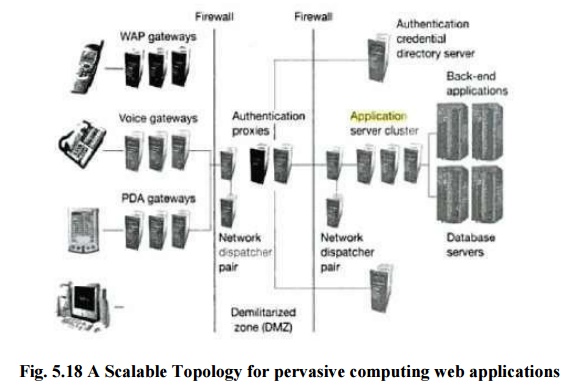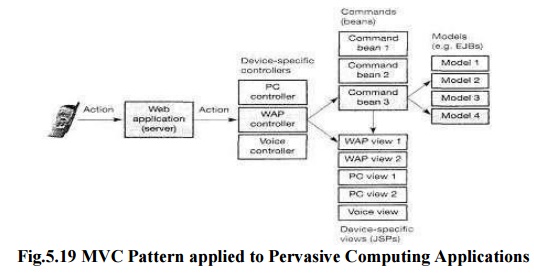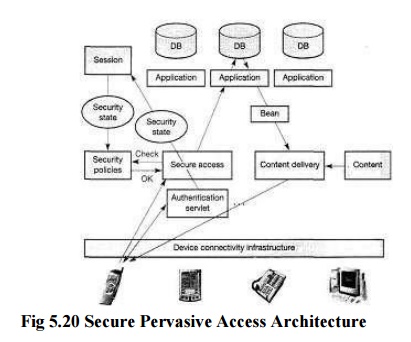Chapter: Mobile Networks : Pervasive Computing
Pervasive Web Application Architecture
PERVASIVE WEB APPLICATION
ARCHITECTURE:
Requirements
of computational infrastructure:
Failure
management.
Security.
Performance.
Dependability.
The architecture for pervasive computing
applications that support multiple devices, such as PCs, WAP phones, PDA and
voice-only phones enabled to access Web servers through voice gate-ways. The
architecture addresses the special problems associated with pervasive
computing, including diversity of devices, markup language and authentication
methods shows how pervasive computing applications based on this architecture
can be secured. Users have many different devices that look and behave in very
different ways. Examples of several kinds of pervasive computing devices
include WAP phones, PDAs, and voice-recognition devices. These devices proving
different user interfaces, use different markup languages, use different
communication protocols, and have different ways of authenticating themselves
to servers.
Scalability and Availability are the two important
issues because pervasive architecture should as scalable to meet the large
amount of user who are subscribing for applications. According to scalability,
when a user accessing the application and if it is not available then the user
will assume that it does not works and the user will switch on to next service.
Thus the service should be available whenever needed.
A scalable topology for pervasive computing is
shown in the Fig. This shows several gateways used for accessing the server.
WAP
gateway which executes WTLS protocol in the direction of clients and SSL in the
direction of servers.
Voice gateways
use voice recognition
engine which consumes
more
power.
PDA
gateway for the PDAs.
Network
Dispatcher which routes incoming request to the approporiate server. Support
handling of HTTP request from a particular client is
always
sent to the same server to avoid repeated SSL handshakes.
Two
dispatchers available to increase availability.
Two
firewalls are placed to perform secure connection.

Authentication
proxy is placed which checks all incoming request according to security policy
defined and use the credentials given by the client in order to secure
transactions. Authentication proxy consumes significant computing power.
Cluster
of application servers are arranged in order to add additional machines if load
increases
Development of Pervasive
Computing Web Application
Business
Logic Designers, User Interface Designers, Application Programmers and experts
for existing database system are the roles
assigned
to implement web application.
Application
flow is designed by Business Logic Designers.
Look and
feel of the system is given by User Interface Designers.
Programmers
are concerned with technologies such as HTML and JSP and implementing the
application logic.
Those
experts who monitor the gateways are responsible in knowing the technologies
such as WML, Voice XML.
Pervasive Application
Architecture:
The model-view-controller (MVC) pattern is a good
choice when implementing Web applications.
Standard mapping of the pattern to servlets, JSPs,
and EJBs, where controller is implemented as a servlet, the model implemented
as a secure EJBs, and the views as JSPs..
As devices
are very different from each other, we can assume that one controller will fit
all device classes. In the MVC pattern the controller encapsulates the dialog
flow of an application.
This flow
will be different for different classes of devices, such as WAP phone,
voice-only phones, PCs, or PDAs.
Thus, we
need different controller for different classes of devices.
To support
multiple controllers, we replace the servlet's role to that of a simple
dispatcher that invokes the appropriate controller depending on the type of
device being used.

Securing
Pervasive Computing Application
Web
applications have to be secured by appropriate encryption, authentication,
using authorization mechanisms.
The secure
pervasive access architecture is designed to process client requests on the
application server in a secure and efficient way.
It addresses
user identification, authentication, and authorization of invocation of
application depending on configurable security policies.

All incoming requests originate from the device
connectivity infrastructure. This infrastructure may include different kinds of
gateways that convert device specific requests to a canonical form, i.e. HTTP
request that may carry information about the device type, the desired language
and the desired reply content type, e.g. HTML, WML, or Voice XML. Examples of
gateways in the device connectivity layer are voice gateways with remote Voice
XML browsers, WAP gateways, and gateways for con-necting PDAs.An important
function that the device connectivity layer must provide is support of session
cookies to allow the application server to associate a session with the
device.The secure access component is the only system component allowed to
invoke application functions. It checks all incoming requests and calls
application functions according to security policies stored in a database or
directory.A particular security state - part of the session state – is reached
by authentication of the client using user-ID and password, public-key client
authentication, or authentication with a smart card, for example. If the
requirements for permissions defined in the security policy are met by the
current security state of a request's session, then the secure access layer
invokes the requested application function, e.g. a function that accesses a
database and returns a bean. Otherwise, the secure access component can
redirect the user to the appropriate authentication page.Typically, the secure
access component will be implemented as an authentication proxy within a
demilitarized zone as shown earlier.Finally, the output generated by the application
logic is delivered back to the user in a form appropriate for the device him or
her issuing. In the Figure, the information to be displayed is prepared by the
application logic and passed to the content-delivery module encapsulated in
beans.The content-delivery module then extracts the relevant part of the
information from the bean and renders it into content that depends on the
device type and desired reply content type, for example by calling appropriate
JSPs.The content-delivery module delivers the content generated in the previous
step via the device connectivity infrastructure that converts canonical
responses (HTTP responses) to device-specific responses, using-appropriate
gateways.For example, if a user accesses the system via a telephone, the voice
gateway receives the HTTP response with Voice XML content and leads an
appropriate 'conversation' with the user, finally resulting in a new request
being sent to the server.
Related Topics